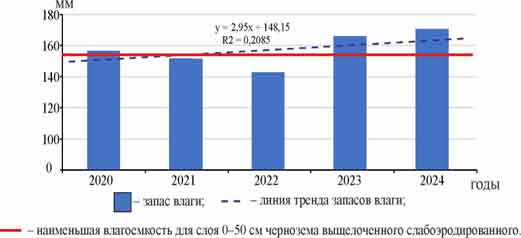Saturation of agricultural soils with snowmelt waters in the south-east of West Siberia
DOI:
https://doi.org/10.31251/pos.v8i3.339Keywords:
soil moisture; soil moisture reserve; meltwater runoff; snowmelt; West Siberia; soils; cold period.Abstract
The aim of the study was to evaluate the efficiency of winter precipitation use by soils on slopes in agrocenoses in the south-east of West Siberia during the pre-sowing period.
Location and time of the study. The cis-Salair drained plain and Bugotaktsky upland in the Novosibirsk region. 2019–2024.
Methods. Soil moisture content was determined using the thermostat-gravimetric method in samples taken with a drill to a depth of 150 cm, layer by layer, every 10 cm. Drilling was performed twice. Soil temperature measurement in the field and arrangement of temperature sites were carried out in accordance with GOST 25358-2012 and RD 52.33.760-2011. Autonomous temperature recorders were installed at the temperature site at the depth of 0, 5, 10, 15, 20 cm, then every 20 cm to a depth of 160 cm. The sensors were programmed for a 3-hour temperature measurement interval. Snow cover thickness was determined by regular snow surveys along parallel routes intersecting the catchment area every 100 m (RD 52.08.730-2010). The density and water reserves in the snow on different catena positions were determined in two replicates using a VS-43 snow gauge.
Results. Based on the weather data analysis during cold periods from 2019 to 2024, a continued, stable increase in precipitation, documented earlier by the authors, was established. During the winters studied, the region received an average of 180 mm of precipitation, which is 1.6 times higher than the long-term average. During the years studied, moisture reserves in the 0-50 cm layer of weakly eroded chernozems were below the minimal water-holding capacity, suggesting that the soils entered winter with sufficient water-holding capacity. Snowmelt in the region begins in the first half of April and, depending on the winter snowfall and weather conditions, can last from 5 to 15 days, during which time the soil thaws no more than 30 cm from the surface. By the time of the greatest surface meltwater runoff, this layer was saturated with meltwater to a moisture content exceeding the full water-holding capacity (thixotropic state). After surface runoff ceased, meltwater was discharged from the soils both deep into the soil profile (assuming the soils had completely thawed) and through subsurface runoff downslope. Exposure to direct sunlight and increasing 24-hour positive air temperatures resulted in additional soil moisture loss through evaporation. As a result, a few days after the end of the snowmelt and surface runoff of meltwater in the 0-30 cm layer of arable soils, moisture reserves were comparable to their autumn levels, and in some years, a deficit (below the minimal water-holding capacity) was observed.
Conclusions. Arable chernozems in south-east of West Siberia may experience soil moisture deficits in the pre-planting period, despite a large reserve of autumn water storage capacity, high precipitation during the cold period, and significant surface runoff of meltwater. Moisture content in the 0-30 and 0-50 cm soil layers after snowmelt, at or below the lowest water-holding capacity after the snowmelt period, indicates a specific absorption pattern of snowmelt water by chernozems in agrocenoses in the studied region. Soil moisture deficits in the pre-planting period on average occur twice per five-year period.
The presence of a subsurface frost barrier during snowmelt is the main barrier to meltwater, which could otherwise replenish moisture in the underlying soil layers. During 10 to 25 days between the end of snowmelt and the start of planting, under the influence of rising temperatures and direct sunlight, valuable moisture from the 0-30 cm layer of arable land is further lost to evaporation. Precipitation in May is crucial for agricultural crops at the beginning of the growing season; however, the emerging trend of a decreasing contribution of precipitation in this month in the total annual precipitation may pose challenges for achieving high and stable grain yields in the region.
Downloads

Downloads
Published
How to Cite
Issue
Section
License
Copyright (c) 2025 The Journal of Soils and Environment

This work is licensed under a Creative Commons Attribution 4.0 International License.






